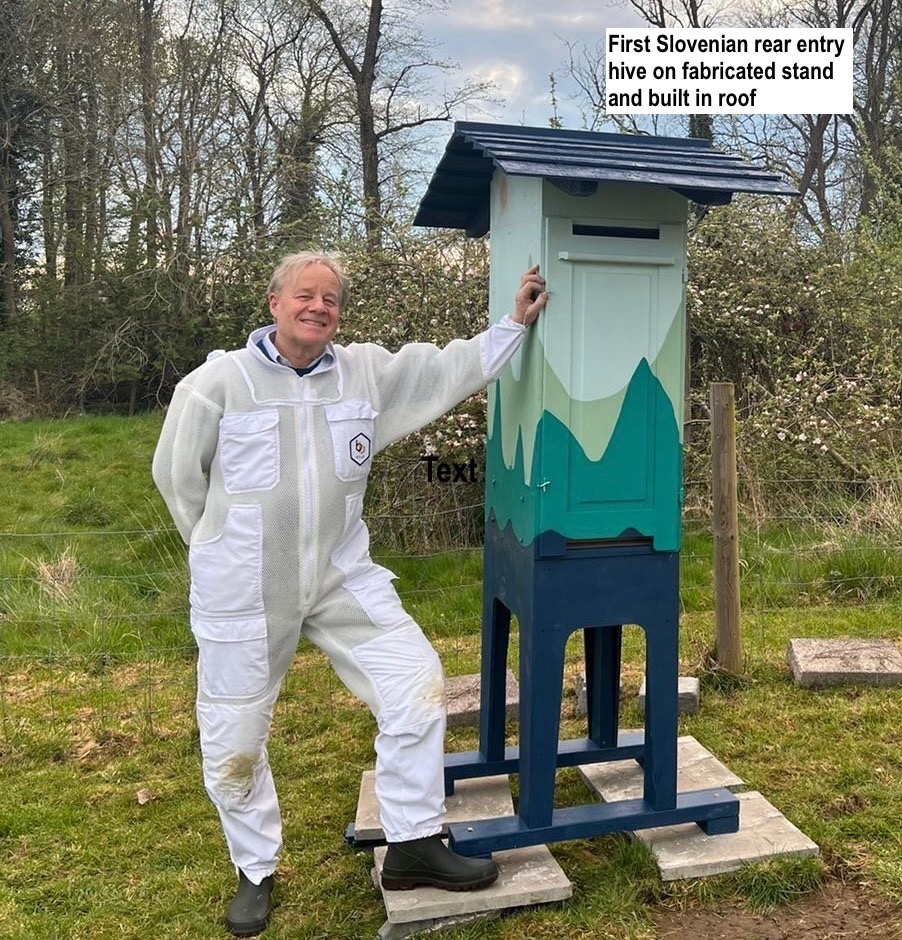
Here we are at the end of February and closer to our active season up in the Northern Hemisphere. We have at timely blog today with some ideas to consider for when we get started. As someone fairly new to beekeeping, Andrew challenges convention and uses his curious and innovative mind to improve things in his apiary through using modern farming methods and cunning inventions. Andrew brings a proactive approach to beekeeping and anticipates problems before they happen.
Thank you, Andrew, for sharing your thoughts and inventions with us. I should point out that Andrew’s Patent Pending Bee Sentry® is not on the market and this blog is food for thought rather than a marketing push. However, I’m excited that Andrew has posted off a couple Bee Sentries for me to try. Andrew tells me that it is possible to make similar entrances successfully yourself from Correx and he may be able to make templates.
All the photographs belong to Andrew.
The importance of Segregation, Hive Insulation and Hygiene.
It all started in autumn ’21 when browsing the internet looking for pure honey straight from the apiarist. I came across the BBKA (British Beekeepers’ Association). A local course was advertised for beginners, so curiosity was aroused resulting in the decision to enroll… .
By the end of the first lecture, I was hooked and decided there and then to join the local bee club to gain practical knowledge on becoming a hobbyist beekeeper. Weekly talks were given at the apiary prior to each inspection… . Presently aged 67, these insightful talks bought back memories of college days studying agriculture and gaining great knowledge on how not to farm! It was great fun learning thrive and survive techniques given by different experienced amateur beekeepers all having an array of different preferences on what may be the best way to manage bees. This came across like a bunch of geeks using Microsoft PCs trying to teach someone using an Apple!
Farming Background.
Coming from a background of mostly arable farming and design, being self-taught to a large degree, and having lost my father when I was aged seven, combined with having a curious mind encouraged independent thinking. With no one to influence thoughts of what’s right or wrong, my mind remained fluid and provoked ideas from an early age. This free-thinking way of gaining knowledge by trial and error from an early age helped me when it came to solving problems and coming up with solutions.
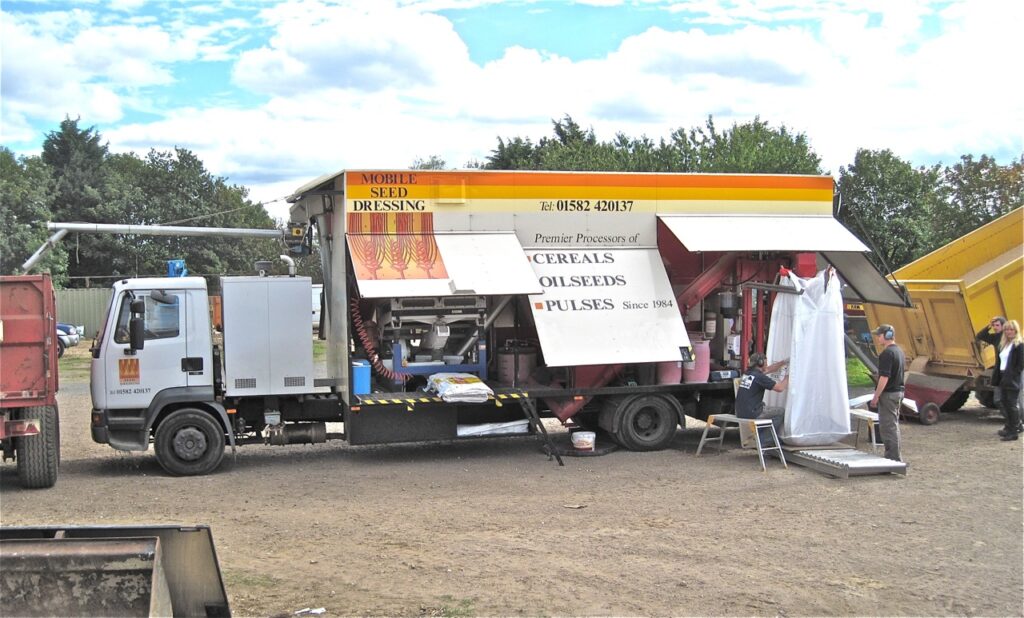
After travelling in my early twenties and taking a break from farming, I returned fired up with ambition and decided to start a mobile home- saved seed contracting business. This involved designing, fabricating and using the machinery to travel to farms after harvest to clean corn and remove weed seeds, chaff and ergot (Claviceps purpurea) etc. This was followed by applying a chemical dressing treatment to reduce disease, and bagging up the crop ready for these treated seeds to be planted for next year’s crop.
Farmers were delighted with results because of the cost-saving from not using a merchant. This also resulted in higher yield. The reason being, only the larger viable seeds ended up being processed. Larger seeds survive better in adverse conditions as opposed to smaller shriveled kernels and they grow more evenly. When it comes to spraying herbicides to control disease, plants at the same growth stage allow the chemical to work better resulting in higher yield.
Segregation.
I also learned the importance of SEGREGATION when processing and ridding weed seeds along with ergot which cannot be overstated. An example being grass seeds growing in rye, wheat, barley and oats that can have ergot spores growing on them. In the right conditions, the fungus spores explode and land on the open rye or wheat at flowering stage. The infected seed then turns black and appears twig like which is poisonous to animals including humans. In humans and other mammals, symptoms of the disease ergotism (ergot sclerotium) may lead to convulsions, muscle spasms, vomiting, dizziness, hallucinations and a gangrenous pain where the victim’s limbs, fingers and nose turn black. It can also cause abortion. Think back to the classic story of “The Witches of Salem” from 1692, resulting in 20 people being burned at the stake, and all because of what we now know was ergotism!
As with all other forms of intensive farming, to avoid devastation SEGREGATION is paramount. Examples are foot and mouth disease, avian flu, and tuberculosis which is spread by badgers roaming freely in the same field as cattle. With humans, of course, along with most other species of animal, in cold winter months disease spreads more rapidly as is universally known.
I’ve got 35 years’ experience in the farming industry. Despite having limited hands-on experience of beekeeping, I’ve watched many related You Tube videos and it appears evident in many cases that some of the rules that apply to all other types of intensive farming have not been adhered to well in the beekeeping industry. Maybe because of traditional techniques continuing to be taught, with some of them having been proven to be scientifically incorrect. Perhaps new ideas have not been believed because of a possible cult status in beekeeping.
Other forms of intensive farming practices have changed enormously since the 1960’s with milk yields tripling, and wheat tonnages nearly quadrupling due to investment in innovation and adopting new ideas and techniques. Within the beekeeping community progress appears to have remained largely stagnant. Thriftiness seems to be rife, often resulting in false economy. An example being purchasing the cheapest replacement queen online from an unverified source. What would be better would be to advise calling a local bee inspector for advice, paying a little more, (the equivalent of a few jars of honey) and ending up with a much healthier and stronger colony which is far less prone to mortality and has a substantially increased yield. Being so tight that your trousers squeak when you walk cannot be considered a wise option with any aspect of beekeeping! In farming, breeding stock is bought from a proven source and will thereby have an excellent chance of having top quality results. The same goes for seed to gain highest yield.
Design Background and Setting About a Solution.

Having designed bibs and bobs for the last three decades from farm machinery to a motor home, I’ve often used ideas from different industries to achieve a successful outcome. I thought it was prudent to try and resolve the issue of segregation in beeping to reduce pests and diseases. The fundamental concern being the importance of isolating colony bees from non-colony bees and stopping other intruders such as wasp, wax moths and mice entering hive throughout the year.
The concept of total year-round segregation can be achieved with a simple device requiring zero maintenance, which has a fully open entrance at all times, it may significantly reduce disease as well as colony loss through in-fighting and robbing. With all types of intensive farming, “prevention is better than cure.”
In the bee world, it appears measures have concentrated on dealing with the problem after it has occurred which equates to “locking the stable door after the horse has bolted.” With this methodology it would seem an almost impossible task to conquer! Additionally, it seems crazy having to learn volumes of knowledge about what could be preventable diseases if one is not going to be proactive. There’s also the inconvenience of moving and juggling hives combined with the constant stress of whether more occurrences of robbing may occur.
Conceptional Ideas and Prototype.
The idea of being able to make a device which only required a couple of minutes to fit and which totally stopped non-colony bees, (including varroa- laden drones) wasp, wax moths and mice entering seemed like a good starting point. For a strong established hive to be placed next to a growing hive or nuc without the worry of invasion made me realise that my invention would save a lot of hassle, time, worry and effort with the added benefit of reducing disease.
Having made a conceptional prototype a couple of years ago, and now modified it to its present form, this device has proved to be 100% successful in halting invasions. To date, 3D prototypes have been printed by a friend who has worked for two global companies for the last 20 years as a top designer, so this has proved to be of significant value. There are other improvements on the way and if they prove successful will help fend off the varroa mite.
Observation.
It has been interesting going out well after dark to observe wax moths, and on cool dewy autumn mornings too watching wasp hovering around and devouring bee carcasses beneath hives. On occasions they sneak inside hives, even with reduced entrances, whilst temperatures remain below 10°C without these devices fitted.
Devices also protect hive entrances from weather elements stopping cool dank wind, rain and snow blowing in which results in a constant cooling of the hive. The new entrance also keeps the front dry so bees fly in and out more frequently when weather is cool or wet and they carry out more cleansing flights which is particularly beneficial for bee health.
Patent Pending Bee Sentry®
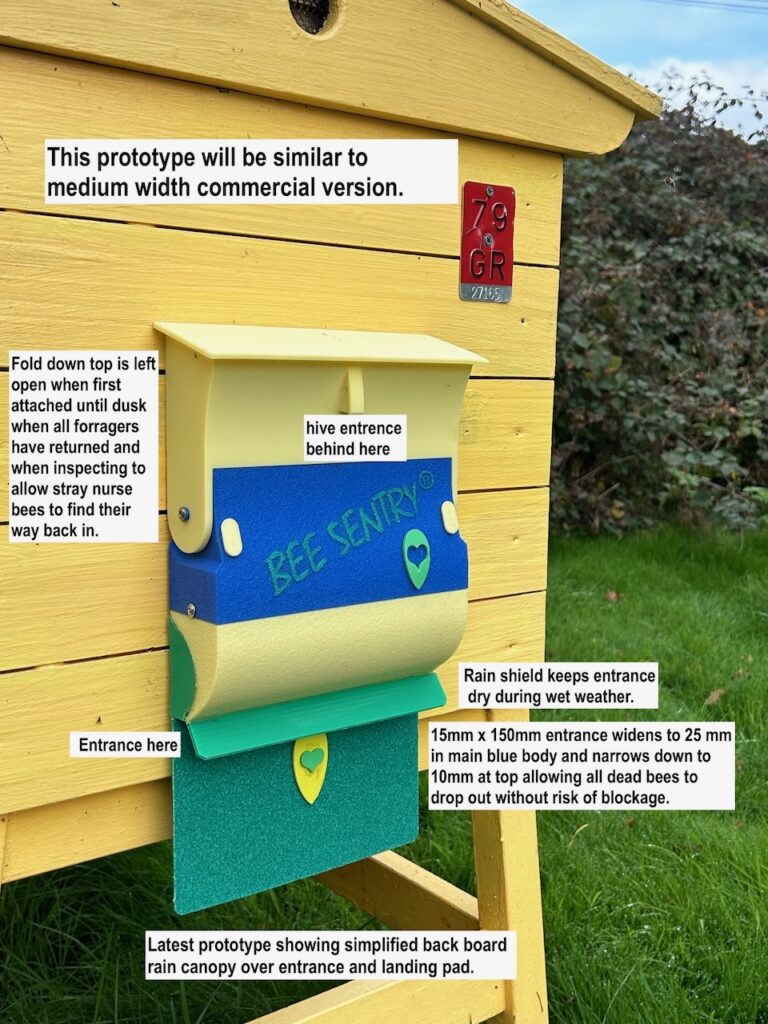
After attaching the Patent Pending Bee Sentry® to the entrance of any flat-fronted hive, the top section is left in open position until dark, when all foraging bees have returned, before closing. In the morning upon exiting hive, bees are forced downward and out of new exit lower down. They memorise this new entrance within a day. Potential invading insects fly around original entrance higher up where smell permeates strongly, and they fail to fathom out where new lower entrance is. This is because of lack of smell at the lower entrance.
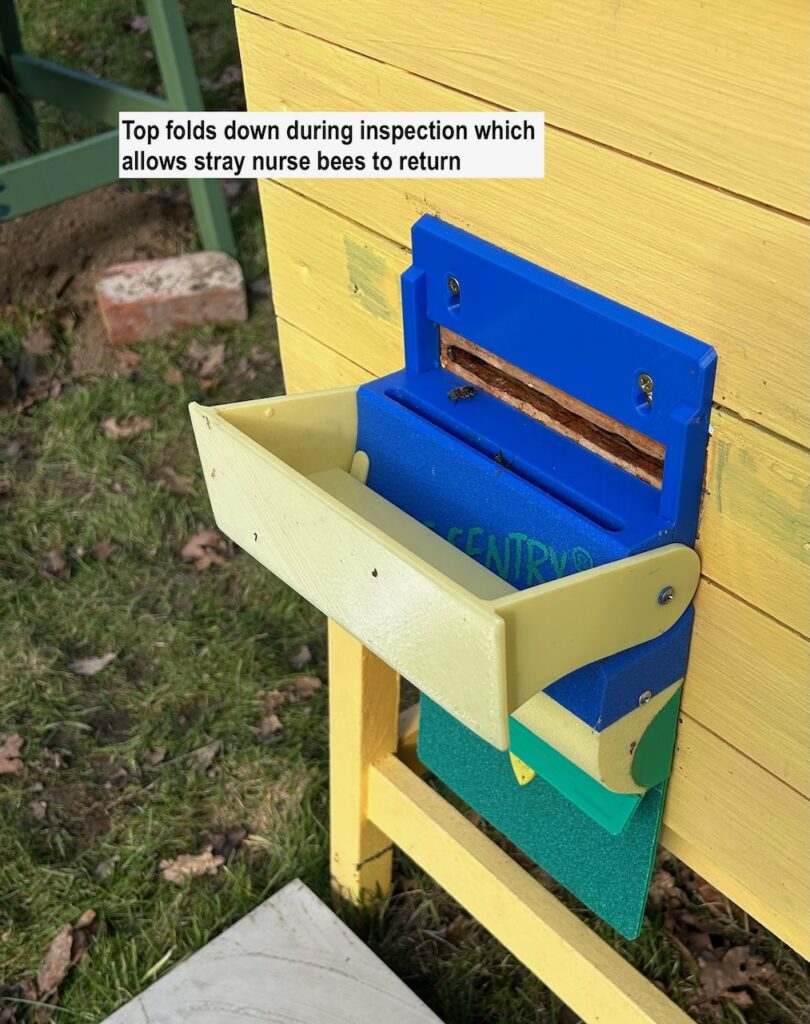
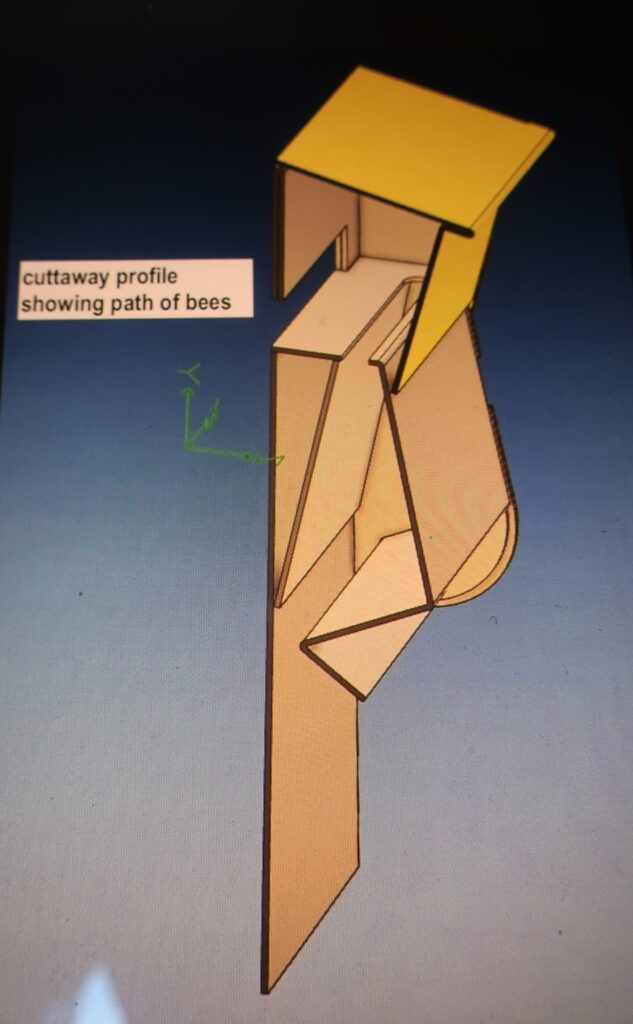
Returning colony bees, which have exited earlier, zoom in having memorised the new entrance, and, with the help of a UV Perspex pad, they land then crawl up inside the unit to where old entrance is situated and they re-enter.
Whilst inspecting the hive, the top of the unit is left open so that any stray nurse bees may find their way back in to avoid perishing. The base of Bee Sentry® has a back board. In summer months if preference is to have open mesh floor, the back board separates the smell of honey permeating from beneath, and prevents confusing the bees entering the hive. It is essential and highly effective.
Hive Insulation.

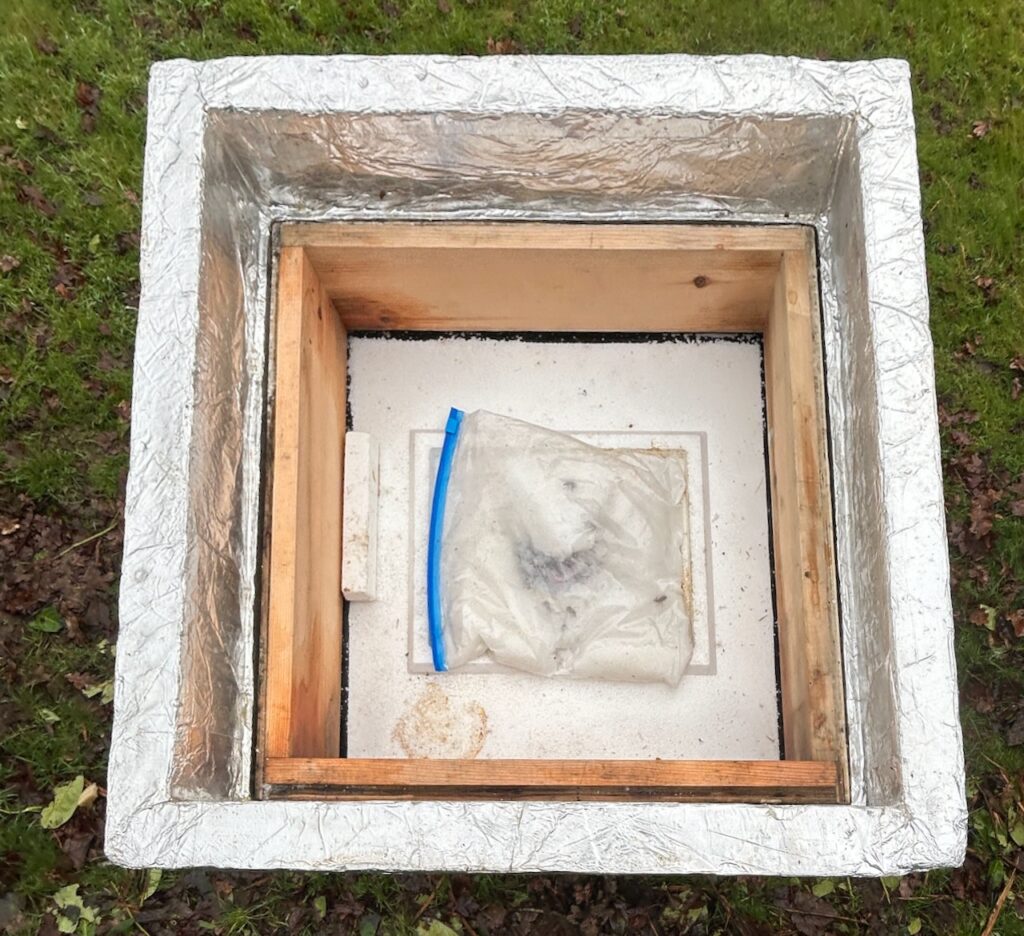
Another observation seems that it’s becoming clear that poly and plastic hives with higher insulation work far better in winter months than conventional wooden hives. From personal experience I have witnessed queens laying brood a month earlier in well insulated hives than poorly insulated hives.
R-Value.
The amount of insulation in any material is worked out and given as an R-value. An R-value shows how good a material is at resisting the flow of heat from one side to the other. If it resists the flow of heat or cold well it is given a high R-value so it will be better at insulating hot or cold from passing through the material.
Wooden hives with a wall thickness of around 25-37mm (1-1.5 inches) have an R-value of between 1.5 – 2 while poly hives have a value of 3.5 – 4. This means they still have on average 30% less R-value than a tree cavity which has an average of around 6. Additionally, bees nest in trees that are often located in woodland protected from the elements.
To increase the R-value in poly hives, I have been making four- sided box sleeves using 50mm (2”) polystyrene insulation board to slot over the outside of them in winter. On the roof section, thickness of sheets is 150mm. This ensures that a condensing action takes place with water collecting on inner sides of hive, leaving tops of frames completely dry. The results are significant. With increased R-value now being similar to that of a tree the bees no longer form a tight cluster. They are therefore able to move around frames more freely without fear of freezing when feeding. In winter, I always put in varroa board, or equivalent, to help retain warmth within the hive. Store consumption notably lessens.
With ivy honey, particularly known for firm crystallising, it requires more energy for the bees to dissolve it with water to make it digestible, but a higher hive temperature reduces solidity. Water vapour given off by the colony breathing in a well condensed hive collects on the side walls enabling the bees to spend more time accessing honey without forcing a return to cluster due to becoming cold. Less energy is therefore consumed overall which extends bee life. This is especially important around February when many colonies being near the end of their lives are at risk of perishing, just prior to colony re-establishing.
With the ideal time to sublimate, with a brilliant device like the InstantVap Lite using OA, being when colony is broodless, a loose cluster due to a warm hive allows treatment to be significantly more effective.
Hygiene.
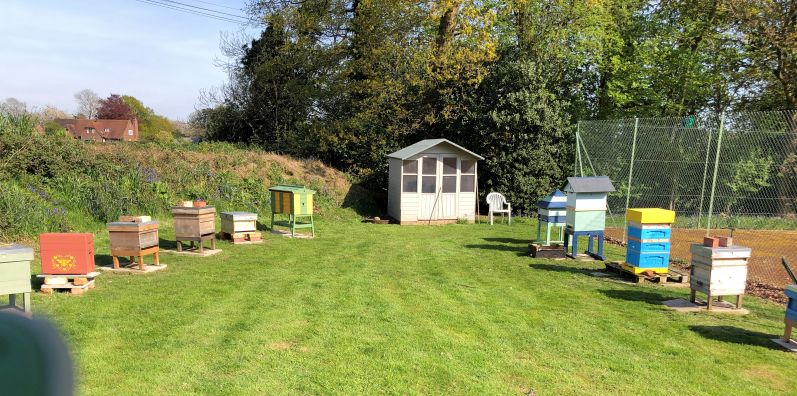
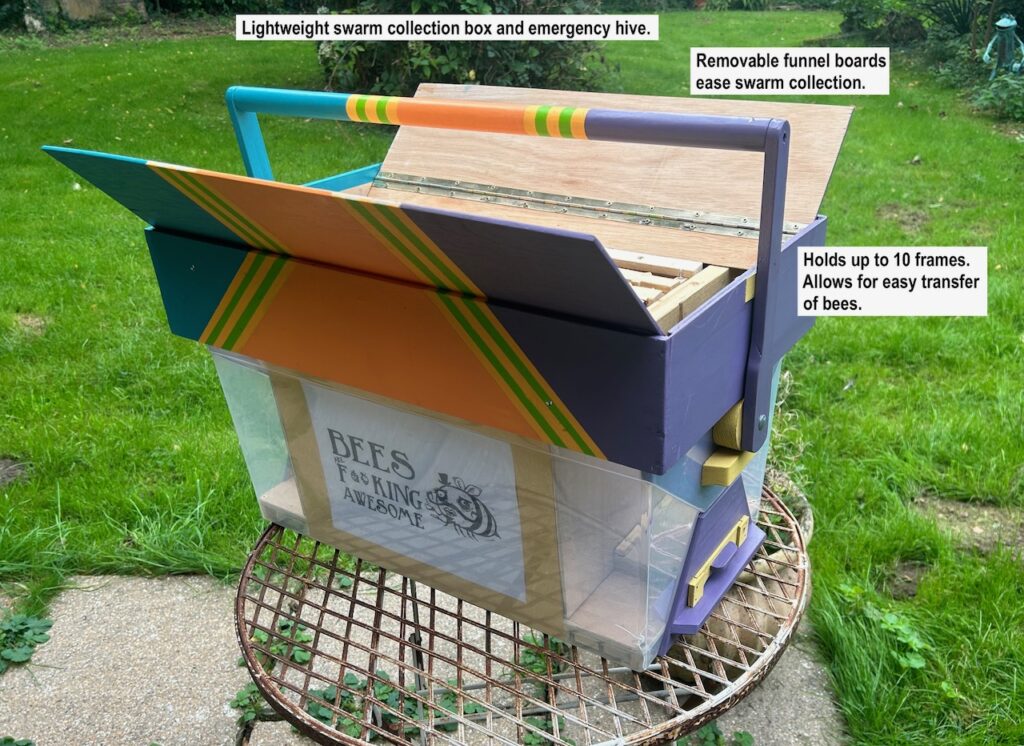
Compared to other branches of intensive farming the importance and practice of excellent hygiene often seems to be overlooked.
How many times have we seen YouTube videos showing beekeepers demonstrating with dirty leather gauntlets and suits without a bucket of soda water in sight. Along with a failure to clean tools between hive inspections and scrapings often being dumped straight on ground, colonies are further challenged. These unacceptable practices may easily and efficiently be resolved—a box of Tiger Grip orange nitrile textured pimple gloves to place straight on hands, or XXL over gauntlets are very tough and last ages. Carrying around a squirty container of something like Dettol which kills 99.9% of bacteria and viruses is good and takes only a few seconds to apply between hives to gloves and tools. This works better for me than a bucket of soda water which can easily be spilt and needs constant replacing.
Working off a decent sized picnic table not only saves frames, boxes and tools etc from being laid on ground but saves backache and makes inspections so much easier. It can be wiped down easily with disposable paper towel to further keep the job hygienic. Bins with heavy or locking lids on site further reduce spread of disease and get beekeeper into good hygienic practices. A large oblong floor tile or similar, placed beneath each hive entrance and tilted slightly to shed off rainwater gives an instant visual warning of possible problems occurring within hive. These commonsense rules of segregation, insulation, hygiene and, the choice of genetically proven stock, are taken for granted in all the other forms of intensive farming to ensure success.
With so much new amazing technology becoming available, combined with letting go of some of traditionalist ways, survival rates should increase along with yield. There should be a considerable reduction in hours spent tending colonies as a result of incorporating these changes which have benefited all other forms of farming enormously.
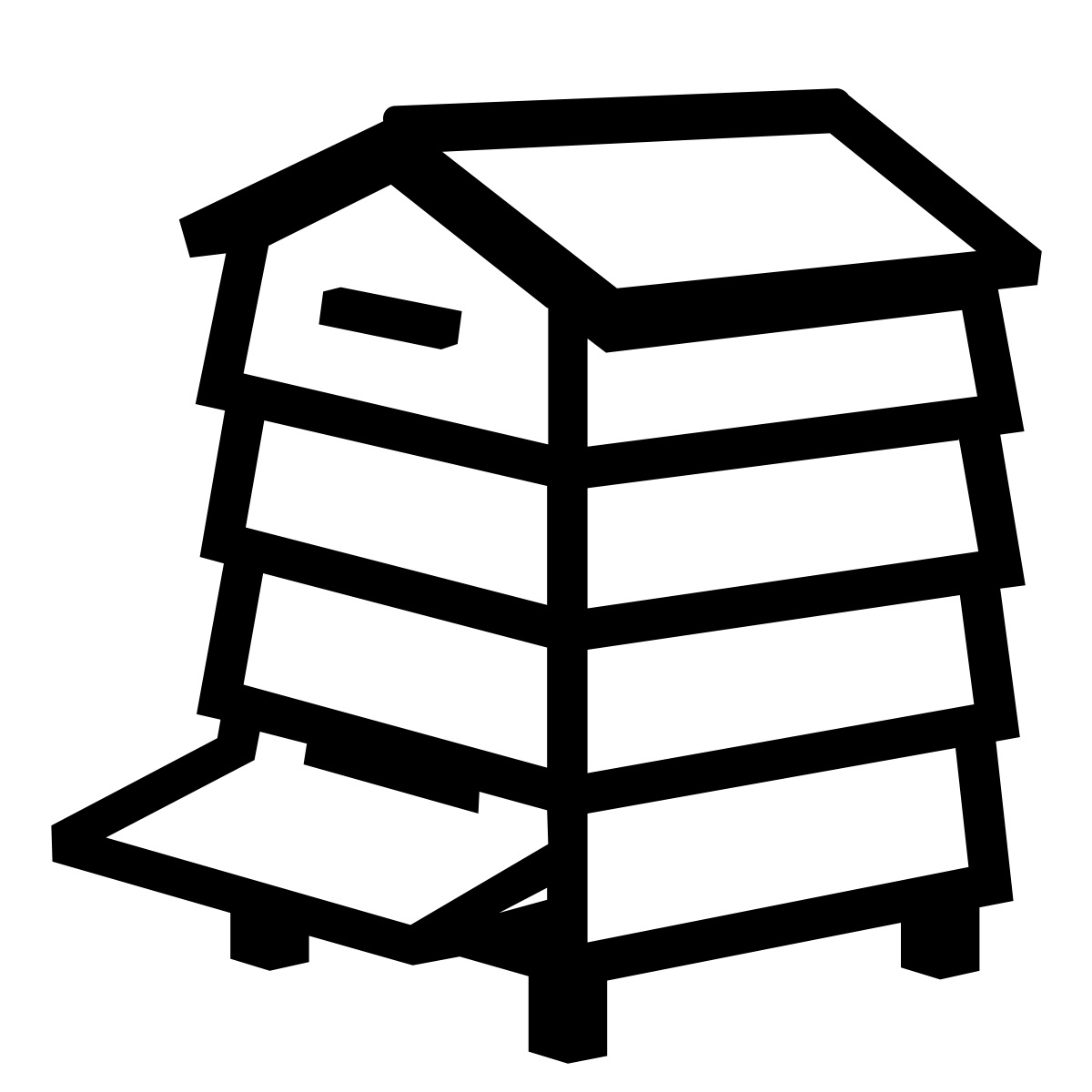
I love to see innovation in beekeeping, well done. I particularly liked the swarm collection idea. Great article.
Interesting reading – always good to see another beekeeper’s ideas.
Although I would still to using the bucket washing soda between inspections – Dettol isn’t going to remove propolis or kill AFB spores 😉
Hi Sally thank you for taking the time to comment.
Your thoughts made me curious as to the effectiveness of using soda, so looked into it and came up with information below.
Washing soda can clean and disinfect beekeeping equipment, but it doesn’t sterilize equipment or prevent the spread of American foul-brood (AFB) or EFB (European foulbrood)
AFB and EFB are introduced and spread by worker bees through drifting, robbing, package bees, swarms, infected comb and re-queening.
Personally keep a separate hive tool for each hive under cover is an inexpensive and effective way to stop spread of AFB spores spreading too.
This being another reason why segregation and hygiene are so important in all forms.
This along with encouraging propolis production in hives for its anti-bacterial properties…
Best wishes Andrew.
Thank you for your reply, and I see you’re absolutely right regarding the washing soda – thank you for the correction!
Thank you Jackie for your kind comments.
Article was meant to be shorter and just about the Bee Sentry, however it is a combination of putting into practice, observations copied from proven farming practices which help reduce labour and mortality.
Thank you Jackie for your kind words.
Originally intended to comment just on the Bee Sentry, however realised it’s a combination of zero maintenance, permenant segragation along with paying particular attention to hygiene, hive insulation, varroa control and choice of queen which make for hassle free bee keeping.
A fascinating and thoroughly informative blog as ever. Thank you Ann and Andrew
interesting to see the innovation although i am a bit confused – does it stop drones from entering the hive again? WIll that not mean that the drones potentially die away quickly with no shelter to return to?
Hello Edel, sorry to hear you’re a bit confused.
In answer to your question, after fitting a Bee Sentry over hive entrance, the first time any colony bees exit, they have to work their way downward to escape from new entrance lower down.
They then memorise this new route. This includes the colony drones.
Drones from other colonies fail to work out this new lower entrance because the smell of honey permeates out very strongly from the original higher up entrance.
All robbers give up after a short while and go hunting elsewhere. For some reason by fitting what is basically a vertical tunnel with no restriction, this fools them.
With a unit fitted, the hive in effect has three entrances, the lower one, then one at the top followed by going through original hive entrance. This tripple whammy effect combined with guard bees leaves intruders completely flummoxed and perplexed.
The other advantage is entrances remain warmer than conventional hives, so guard bees remain more alert at colder temperatures.
Hope this makes sense.
Best wishes,
Andrew